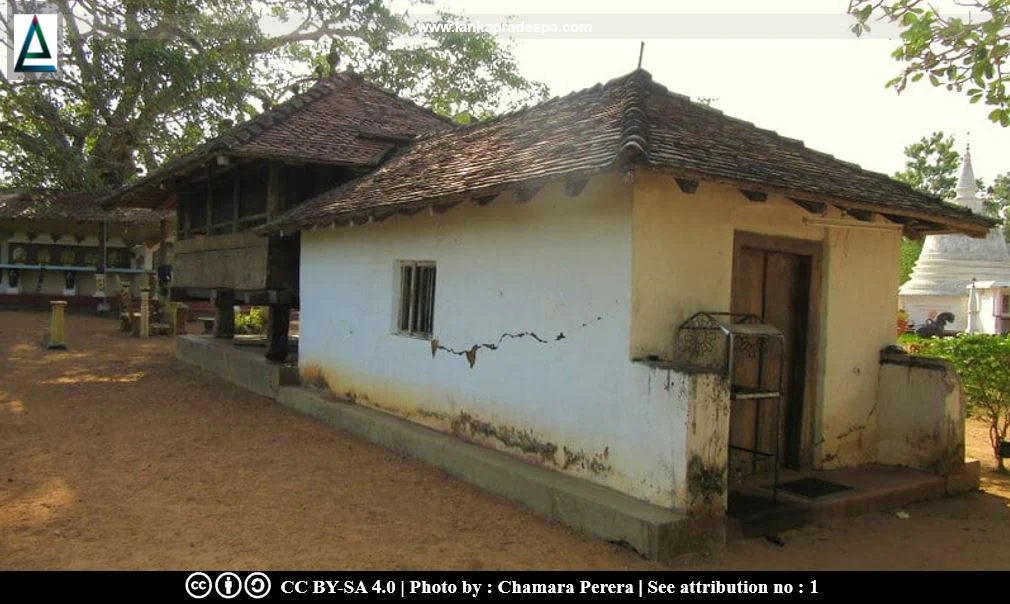
Yataththawala Tempita Viharaya, also known as Yataththawala Sri Bodhivamsarama Raja Maha Viharaya (Sinhala: යටත්තාවල ටැම්පිට විහාරය, යටත්තාවල ශ්රී බෝධිවංශාරාම විහාරය), is a Buddhist temple situated in Yataththawala village in Kurunegala District, Sri Lanka.
History
As the presence of a Tempita Viharaya (a temple of pillars), the history of this temple can be dated back to the Kandyan Period.
Tempita Viharaya
Tempita
Viharas (the temples on pillars) were a popular aspect of many Buddhist temples during the Kandyan period. These structures were usually built on a wooden platform resting on bare stone pillars or stumps which are about 1-4 feet tall. The roof is generally made of timber and held by wooden stumps. The walls are usually made of wattle and daub and they form the main enclosed shrine room containing the Buddhist sculptures and murals belonging to the Kandyan style. Some Tempita Viharas have narrow verandas and ambulatories circulating the main enclosed space. The construction of these buildings was started in the 17th century and
lasted until the end of the 19th century (Wijayawardhana, 2010).
Yataththawala Tempita Viharaya
The Tempita Viharaya is the main attraction of this temple with archaeological value. It has been built upon 6 stone pillars and a fully enclosed Hewisi Mandapaya (the pavilion of drummers) has been attached to the front of it. The deck of the building is made of wood and can be approached through a staircase. A narrow ambulatory has been built around the inner shrine room that preserves the Buddha statues.
The inner shrine room can be entered through a door decorated with a Makara Thorana (dragon arch). A seated Buddha statue accompanied by two figures of Sariputta (left)
and Moggallana (right), the two chief disciples of Gautama Buddha, are
found inside this shrine room. Two standing statues of Buddha with the gesture of Vitharka Mudra are also found facing each other at both left and right walls. Above the heads of the two figures of Sariputta and Moggallana are two clocks with Roman numerals depicting times 9.08 (left) and 7.12 (right). The year 1898 is depicted on one clock (right) along with the name of someone, probably the artist.
The outer walls of the shrine are decorated with paintings depicting Arhats, Mara Yuddhaya (defeat of Mara) and the tale of Sasa Jatakaya.
A protected site
The Tampita image house (image house built on stone piles) and Hewisi Mandapaya belonging to the Yataththawela Bodhiwansarama Purana Viharaya premises situated in No.532 Yataththawela Grama Niladhari Division in the Pannala Divisional Secretary’s Division are archaeological protected monuments, declared by a government gazette notification published on 24 July 2009.

.
Attribution
1) LankaPradeepa.com would like to thank Chamara Perera for providing the necessary photographs required for this article. All the photos are published here with the permission of the author.
References
1) The Gazette of the Democratic Socialist Republic of Sri Lanka. No: 1612. 24 July 2009. p.1023.
2) Wijayawardhana, K., 2010. Sri Lankawe Tampita Vihara (In Sinhala). Dayawansa Jayakody & Company. Colombo. ISBN: 978-955-551-752-2. p.12.
Location Map
This page was last updated on 6 January 2023


